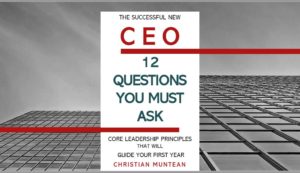If you only fall in love with one thing at work…it should be this.

 “Muddy language usually means muddy thinking.” – Max De Pree
“Muddy language usually means muddy thinking.” – Max De Pree
Clarity.
Much of my work with clients is defined by that word. Helping clients create clarity.
Conceptually, people understand the need for clarity. They will agree that when details are lacking, or ambiguous, or conflicting, it creates problems.
But it takes awareness and effort.
And that’s where things often fall apart. Leaders don’t recognize a lack of clarity. Or don’t put the effort into creating it.
Leaders Are Either the Problem or the Solution
A leader’s ability to be externally clear in communication is a reflection of internal clarity of thought.
Simply – you can’t lead to a future (or culture or performance level) that you can’t see. If you can’t see it, you can’t articulate it.
For example: If you have done the work to become clear about the values of your organization, and how those inform decisions and behavior throughout, it’s easy to communicate about this.
However, if you haven’t, you may have nothing to say. Or you may be confusing or even conflicting.
I often speak with leaders who are frustrated with the performance of an individual or team. But when I ask them what their expectations are – they often struggle to tell me.
One of the most common challenges on teams has to do with meetings. Productive meetings share certain things in common:
- The goal, purpose, or “work” of the meeting is clearly and narrowly defined. Everyone knows what decision or product the meeting is supposed to produce.
- Agreements are made concrete. Someone captures the agreements made in meetings. This might be in minutes or a follow-up e-mail summary.
- Action steps are defined. Any follow-up work has been clearly assigned to someone, deadlines or mileposts are determined, and everyone knows what success will look like.
Good, smart, easy-to-work-with people can waste an enormous amount of time and generate unnecessary friction when any of those three are lacking.
Leaders create the tone. You set the expectations. If you drive towards clarity, others will as well. If you accept ambiguity, others will too.
Common Hindrances to Clarity
Most leaders have thought they communicated well. But discovered they hadn’t. Here are some of the reasons why this happens:
They aren’t clear to themselves: I mentioned this above. Many leaders have a vague but unspecific sense of what they want or are trying to say.
Others should figure it out: Leaders assume that others should be able to connect the dots or figure out what they are thinking.
Don’t break it: Some have a fear that further discussion or clarification will spoil (as opposed to strengthening) an agreement or relationship.
It’s not nice: The fear that creating clarity is “unfriendly” or “untrusting.”
Ambiguity Breeds Conflict
Much of my work has to do with helping people resolve conflicts. Many of those conflicts have to do with ambiguity.
Someone wasn’t clear. Agreements weren’t written down. Different interpretations occur. Everyone insists they can read someone else’s mind and intent.
There are many workplace dynamics where clarity instantly improves the quality of communication and results.
Here are three. When you improve clarity in any of these three, you’ll find both performance and morale will improve. Improve clarity in all three and you’ll easily outperform the norm.
- Employee issues (Specifically performance or behavior.)
- Meetings (All kinds)
- Delegating (Assigning responsibilities to others)
How To Be Clear
There are a variety of ways to achieve or improve clarity. It isn’t always a one-size-fits-all approach. But, if you answer the questions below, you’ll find it easier to be clear on the topics above.
Questions to ask yourself:
- How do our Values and Vision guide us on this topic/situation? A clear Values and Vision statement should be one of the most heavily used tools in your tool belt. Decisions, expectations, and behaviors should be in alignment with your values and vision. If they aren’t – you should have a serious conversation about what that means.
When well-defined – I watched clients use these to successfully navigate questions from high-level strategy to individual situations.
- What do I/we really want? Get clear (and be honest) about what you really want as well as what makes that important to you.
- What is the most important question that needs to be answered here? I’ve found that framing things in terms of “what is the most important question” tends to focus conversations dramatically. A great deal of confusion in the workplace is due to people thinking they are talking about the same thing – when they aren’t. Examples of questions:
- Employee issues: “What is the specific behavior that is creating a problem? What behavior would I prefer to see?”
- Meetings: “What is one thing that needs to be accomplished at this meeting?”
- Delegating: “What will indicate success or high performance?”
- How can I describe this objectively?: Take out the vague, value, or judgment-laden descriptors. I don’t know what a “toxic” environment is. Neither do you. However, I do understand what is meant by a team where people avoid addressing conflict openly and tend to talk behind the backs of others.
- How can I describe what I want objectively? Saying that we want a better “work ethic” doesn’t mean anything. Defining clear indicators of successful performance does.
Fall In Love With Clarity
The benefits of clarity are vast and most are realized quickly: Reduction of conflict, improved performance and morale, increased trust, high customer satisfaction, less failure work, improved quality control, and so on.
All of which directly translate into creating healthy, effective, and profitable workplaces.
What’s not to love about it?
Take good care,
Christian
Let’s connect.
I’m passionate about helping leaders to create workplaces they love going to and increasing the value of the services they offer. My results-oriented approach is tailored to each client’s specific situation and needs. As a leadership coach, I have developed a wealth of resources to help you and your team grow and become stronger.
Weekly Newsletter – sign up to receive my weekly articles addressing critical leadership challenges and issues.
The Leadership Coach Podcast – In my podcast, we explore effective, high-impact, and enjoyable leadership. Subscribe.
Resources – Visit my website’s Resources page for e-books, webinars, training, and leadership coaching opportunities for you and your team.
There are 𝟭𝟮 𝗰𝗿𝗶𝘁𝗶𝗰𝗮𝗹 𝗾𝘂𝗲𝘀𝘁𝗶𝗼𝗻𝘀 to ask before accepting a new CEO position. Do you know what they are? Instantly download my free e-book here.
Find the value of your company with my free assessment tool: The Value Builder System
The Value Builder System™ is a 13-minute online questionnaire that evaluates your business on the eight factors that contribute more to its attractiveness and value. These factors are scored on a scale of 1-100. Businesses that score over 80 are likely to command 70%-100% higher value than others.
Opportunities
Free Resource: How To Accomplish More Without Doing More is a workbook I created to walk leaders through a process of helping you own your calendar, liberate your time, and still get more done. Download it for free!
Executive and Leadership Coaching: Do you feel overwhelmed? Are you not getting the results you expect from the effort you are putting in? Do you find yourself facing similar challenges time and time again? Would you like to change specific ways of relating or reacting? If you would like to experience predictable, measurable growth Contact me.
Profitable Exit Strategy Workshop: Are you a business owner or partner? Over 55? Starting to think about exiting your business or active management in the next 3-5 years?
- Curious about what your business might be worth?
- Would you like to discover the specific steps you need to take to increase its value and become highly attractive to a buyer?
- Are you planning on handing it over to family or employees and you want to ensure long-term success?
If so, contact me now
Categories
Get Christian’s Newest Book: Train to Lead

Download my free 10-page eBook:
How To Accomplish More Without Doing More:
Eight Proven Strategies To Change Your Life
Discover how to save eight hours during your workweek-even if you're too busy to even think about it. The resource every maxed out executive needs.

